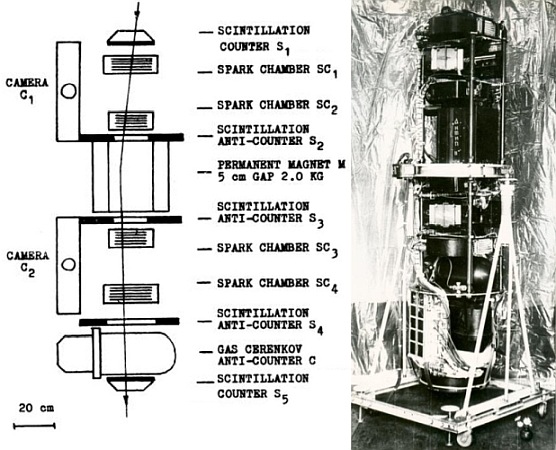Purpose of the flight and payload description
The ANTIP-1 was a balloon borne magnetic spectrometer, developed in late 60's at the Abram Fedorovich Ioffe Physicotechnical Institute, of the Russian Academy of Sciences in Leningrad (now St. Petersburg) which was used to search for galactic antiprotons.At left, we can see an scheme of the instrument along with a picture of an earlier model (click to enlarge).
The magnetic spectrometer consisted of a monitor managing telescope of four scintillation counters detectors (S1 to S4) which determined the solid angle of the instrument for detecting particles and made it possible to distinguish separate singly charged particles from the amplitude of the signals in the scintillators. A fifth scintillator (S5) was added in later models just between the lower spark chamber / Cerenkov counter. The counters S2, S3 and S5 were switched on in the mode of anticoincidence with S1 and S2 and were used to protect against the background of nuclear interactions in the material of the spectrometer.
Four Spark Chambers (SC1 to SC4) with 4 gaps in each were used for determining the trajectories of particles through the device, while a permanent magnet (M) which deflected charged particles together with the trajectory measurements, made possible to measure the rigidity spectrum of the particles and to separate the particles according to the sign of the charge. A threshold Gas Cerenkov Counter (C) filled with ethylene and switched in anticoincidence mode with the signals of the scintillation telescope and a directional solid-state Cherenkov Plexiglas Counter (CPC) allowed velocity selection of the particles and, together with data on the rigidity of the detected particles, made possible to separate singly charged particles of the same charge by mass. The Cherenkov detector (CPC) and the use of the time-of-flight of particles between the upper (S1) and lower (S4) scintillation counters offered shielding against albedo particles.
Interaction trajectories with the detector of incoming particles was registered by two Photo Cameras (C1,C2) located between superior and inferior pair of spark chambers. They recorded tracks in the spark chambers with an accuracy of coordinate measurements of 0.1 to 0.2 mm. In a normal flight each camera was able to record about 30.000 events.
The instrument itself measured roughly 2 meters of height and 80 cm of diameter. For each flight it was enclosed in a cilindrical sealed aluminum container tube. The container tube was isolated from harsh stratospheric temperatures by an outer Styrofoam polystyrene container which served at the same time to absorb the shock of the landing. The onboard systems were powered by silver-zinc batteries with a total power consumption of about 50 W / h. These batteries were placed in a separate container and connected with a cable to the device. The weight of the entire instrument was about 420 kg.
The apparatus was calibrated before and after each flight using the natural background of atmospheric muons, which served to measure and monitor the required parameters of the device. The design was maintained mostly unaltered -with only minor improvements and modifications- throught the entire program of measurements which spanned from 1969 to 1991. A total of four units were constructed that were flown in more than 20 balloon flights over the URSS and China. A modified version of the instrument also was adapted to be flown in different airplanes as part of a program to study the effects of exposure to cosmic radiation by passengers and flight crews of Tu-144, and Concorde supersonic aircrafts.
Details of the balloon flight
Balloon launched on: 11/18/1969
Launch site: Volsk Balloon Facility, Saratov, Russian Federation
Balloon manufacturer/size/composition: Zero Pressure Balloon
End of flight (L for landing time, W for last contact, otherwise termination time): 11/18/1969
Balloon flight duration (F: time at float only, otherwise total flight time in d:days / h:hours or m:minutes - ): 7 h
Landing site: Near Tselinograd, Kazakhstan
External references
- The History of Antiproton and Deuteron Investigations in IPTI People, Science and Flights 2nd PAMELA Collaboration Meeting - 19-21 October 2009, Lindau, Germany
15668If you consider this website interesting or useful, you can help me to keep it up and running with a small donation to cover the operational costs. Just the equivalent of the price of a cup of coffee helps a lot.


